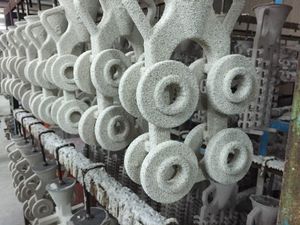I have had a rapid-fire couple of weeks. Yesterday was hectic but included at least a hint of normalcy; the rest of the week should continue that trend. Anyway, short notes today; expect more as things level back out 💞
SCOPE CREEP.
- A few hot jobs:
- Part of what has been hectic about the past few weeks has been my workshop move — out of a light industrial building in Bed Stuy and into my cozy (if dimly lit) basement. This is about eighty percent done; if you've got any interest in helping me get to a hundred, please peruse this list of equipment that's still for sale 💸
- I'm currently reading Computing Taste with the SOW Reading Group; the author, Nick Seaver, will be joining the group for a chat on 2024-05-30 and you can join us, too, by becoming a Member. I'm also reading Daniel Everett's Don't Sleep, There are Snakes, which is the subject of this 2007 New Yorker piece, and Michaeleen Doucleff's Hunt, Gather, Parent, which was the subject of a thoughtful and compelling thread on the #community-parents channel of the SOW Members' Slack. And, I'm still picking through Birth of a Bridge and The White Album.
- I've spent a bunch of time looking up words on Etymonline recently. The site, which is ad- and Patreon-supported and was founded around the turn of the century, is the project of a Civil War historian in Pennsylvania who wanted somewhere to write down the things he had learned about word origins. As of 2015, his motivation for maintaining the site "has grown a good deal more tangled;" the word sources that he compiles are often tangled as well.
What words have I been looking up?- Crisis, which is derived from the Latinized Greek krisis, which was used by Hippocrates to mean "the turning point in a disease."
- Barbecue, which comes from the same root as buccaneer.
- Quay, which is pronounced like key and comes from the PIE root for "to enclose... fence."
- Loggia, which refers to a covered outdoor corridor; this translates to lodge in Italian, and probably comes from the same PIE root as leaf, for the fact that roofs might be constructed of foliage.
- Argentina, which comes from the latin argentinus: "of silver." Note that silver is denoted as Ag on the periodic table.
- Shou sugi ban (known in Japan as yakisugi) is a method of finishing softwood by burning its surface. I first became aware of it when Calvin Klein, whose summer house I was working on, requested that the mahogany veneers that we were applying to his aluminum-framed, hurricane-rated sliding doors should have a torch waved at them to create a blackened appearance. I was appalled, and in the end I made enough of a stink to get "torch the doors" onto a list of things we wouldn't agree to do.
But yakisugi really is pretty. Here's a video of it being done in the traditional manner (no torch), by baling planks of cedar together into a triangular flue, which is then placed directly over an open fire. Once the flue's interior surfaces are aflame, it is set atop a couple of sawhorses and unbundled, and the charred faces are sprayed with water to stop the burning. Later, the burned wood is brushed to remove excess soot and expose the grain; oil may be applied in an effort to make the color and texture last longer.
In lieu of yakisugi, we applied an obscure black paint to Calvin's doors. It arrived to us in steel five-gallon pails whose identifying marks had been scratched out, presumably in an effort to obfuscate their manufacturer and therefore protect the reseller from being cut out of the sale. The pails' only identifying mark was a picture of a deep orange persimmon, and I suspect now that the paint was shibuzumi, which is made of pine soot, iron oxide, and persimmon tannins (which are called kakishibu; these can apparently also be used to dye clothing).
I wasn't around to see the completion of Calvin's house, but I learned later that whatever this black paint was, it was apparently electrically conductive — which, given the fact that Calvin's doors were electronic and communicated with each other via the tracks on which they rolled, caused myriad problems. - Super Mario Clouds is a 2002 video art installation by Cory Arcangel. Arcangel hacked a Nintendo NES Super Mario Brothers cartridge, removing all game elements except the blue sky and the puffy white clouds, which scroll from right to left. A version of Super Mario Clouds is on Arcangel's YouTube page; a copy is also owned by the Whitney Museum in NYC.
Thanks as always to Scope of Work’s Members and Supporters for making this newsletter possible.
Love, Spencer.




